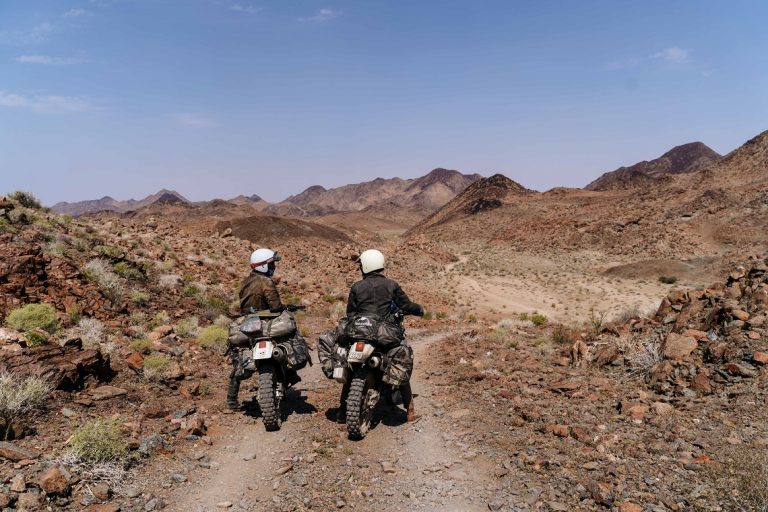Simon Pocock and his mates go in search of adventure in the remote and wild west of South Africa. But with fuel and water scarce, and plenty of mechanical issues to overcome, will they all make it home in one piece?
Many South Africans refer to the west coast as one of the final frontiers, somewhat desolate, untouched, and with a harsh edge to it. In many ways, it’s the complete opposite to the popular and developed East Coast. It’s an alluring destination for folk looking for wild and untouched spaces with the added challenge of navigating the unknown.
As a group of mates, myself, Scotty, Archie, and Bernard have known each other and travelled together for years. We’d been eyeing up this section of coastline a long time. And of course, it had to be done on motorcycles, the perfect means to explore the coastline. After the nationwide lockdown of 2020, it was time to go. Leaving on a bike trip in the dark is never ideal, especially when you were meant to depart earlier in the day. It meant we were already behind schedule which was a quick and effective reminder to drop the schedule entirely and simply go along with the momentum of the journey.
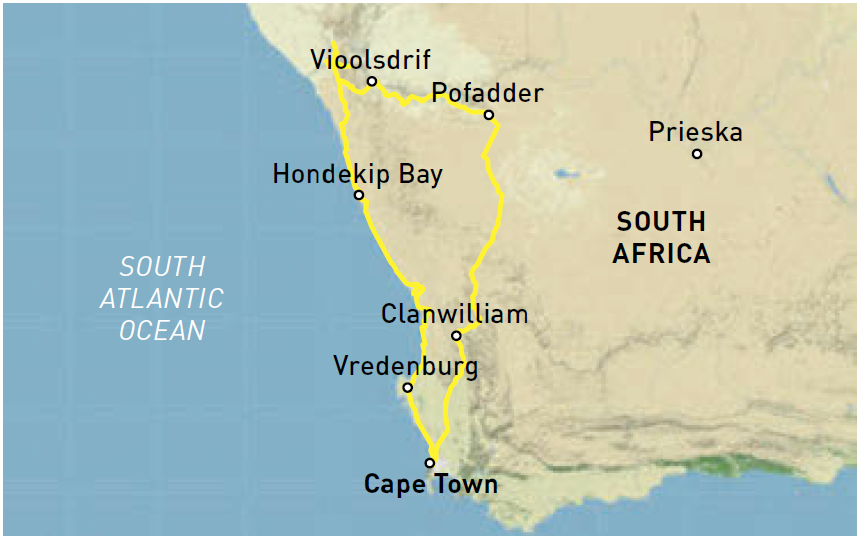
The first few hours were just about getting out of Cape Town, clearing the city lights, and getting used to the idea that the journey had begun. We’d checked out physically and mentally and hit the road. Scotty, Archie and I made it to Yzerfontein, a small fishing village about 60 miles up the coast. Three of us shared a tiny room for one, camped out and spread across the floor.
Our lovely hosts offered us dinner in their home and we were grateful to kick off the trip in authentic west coast style. The following morning, we would meet up with Bernard and keep moving north, now as a crew of four. We were bound for the Namakwa Eco-Trail. We’d get there by following the west coast sand tracks for a few days. Then we’d traverse the mighty Orange River inland which forms the border between South Africa and Namibia.
Seven days later, we’d turn and head south back to our home via the open dirt tracks of the Karoo desert region. Unfortunately, only a few hours into our first proper day on the road, we were already syphoning off petrol from Bernard’s bike to try and figure out what was going wrong with his fuel system.
He’d just finished rebuilding the bike, a beautifully restored and upgraded Honda XR650R, a desert racing legend. It was perfect for our trip, if it kept going. But no trip is complete without its challenges, and our small crew has seen quite a few over the years of riding together. We kept him moving and made it to our first campsite of the trip.
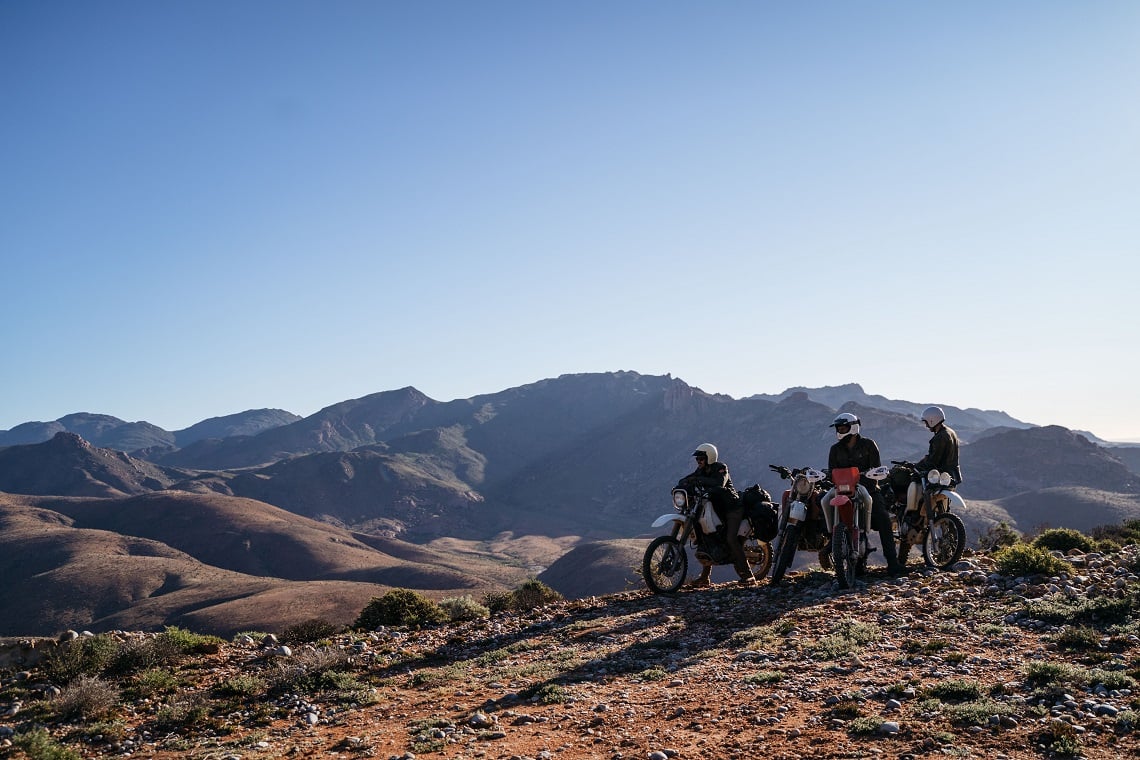
After finding the perfect secluded cove to camp in, just outside the small town of Lutzville, we settled into what would be our travelling rhythm for the next few days. The simple joy of riding through a landscape and camping along the way. Keep the plan loose, allow it to evolve with the terrain, and of course, embrace the challenges we would face along the way.
We knew our next few days of riding would be sandy, not the easiest surface considering our bikes were weighed down with our traveling kit, but at the same time we were grateful not be on bigger, heavier machines, that we would have to wrestle through the sand.
We were all riding thumpers; simple single-cylinder dual-sport bikes that were designed in the ‘90s and capable of doing everything we needed. But most importantly, they were light enough to go wherever we wanted to go.
Ghostly towns
Our second day on the coast found us up in the Namaqua National Park, a space famous for its wildflower fields and untamed stretches of majestic coastline. A swim in the ice-cold Atlantic and a night of camping in the sand was a fine send-off from the west coast before we shifted our bearing slightly inland and headed for the Richtersveld and its lunar landscape of rugged mountains rising up out of arid desert.
After leaving Namaqua National Park, we passed through some of the old and ghostly-looking towns that are scattered across this region, which is famous for its lucrative diamond mining. These towns were sprawling with industry and people many years ago but now appear to be a shadow of their old lives. We stopped in Kleinsee, a spookily quiet place, to pick up supplies for the next few nights. Luckily Scotty managed to find some industrial style goggles in the store to make up for the fact that he had lost his riding goggles a few days prior.
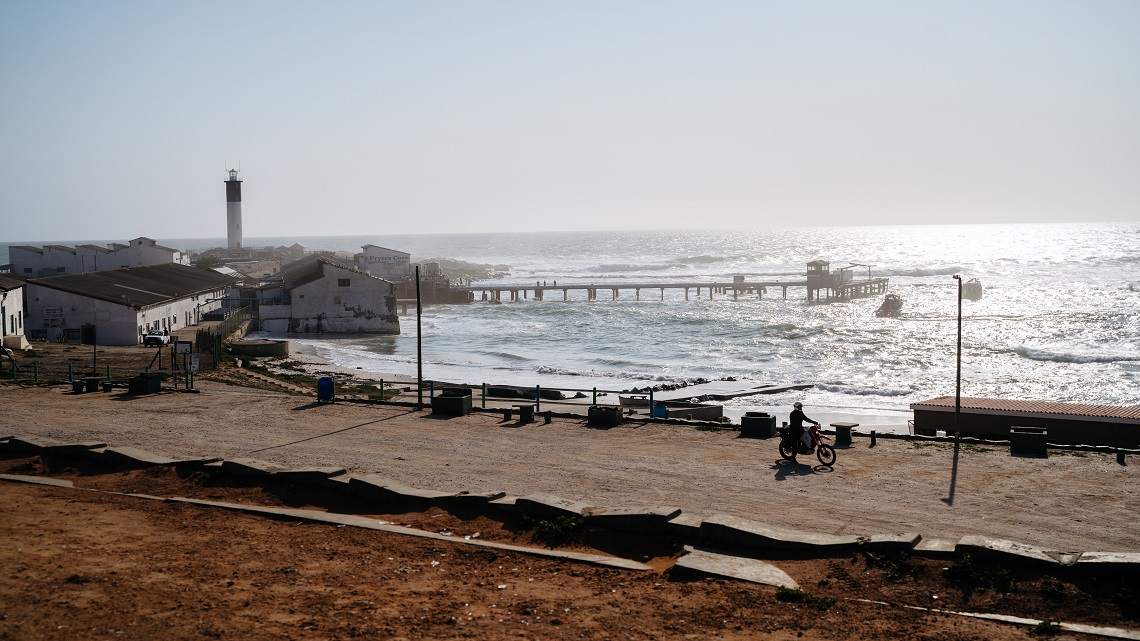
The white sand of the coastal areas we’d ridden over the first two days of our trip were soon replaced by the rich warm hues of soft, silky desert dust. We’d left the ocean behind and were heading into what felt like another world. Later in the day we pulled off the road to find a campsite in the shadow of a quiet foothill and settled in for the night.
After spending time foraging around for some wood, Archie got the campfire going, and we spent an evening under the stars, eating, talking, and enjoying being on an adventure together once again.
We were in need of fuel the next morning, but towns were getting few and far between as we rode into ever more remote country. After trying and failing to find fuel in a small village called Sanddrif, we were forced to detour slightly in a northerly direction to the Sendelingsdrfift border post which had a small petrol station. At least it made for a shady lunch spot as we peered out over the mighty Orange River while debating our movements over the next few days.
Toughing it out
Although our routes are always pretty flexible on trips together, and generally require a bit of adaptation along the way, sometimes things can get over ambitious, or even a bit too risky, when picking a general direction or lesser-known trail.
This trip had one such section, the Kuboes 4×4 trail which would prove one of the toughest challenges of our lives. After our fuel stop and lunch alongside the Orange River, we hit the road once again and reached the village of Kuboes. It was the last sign of civilisation we saw before we officially started the 4×4 trail of the same name.
We eagerly made our way along the route and it didn’t take long before we encountered the first signs that there would be difficulties ahead.
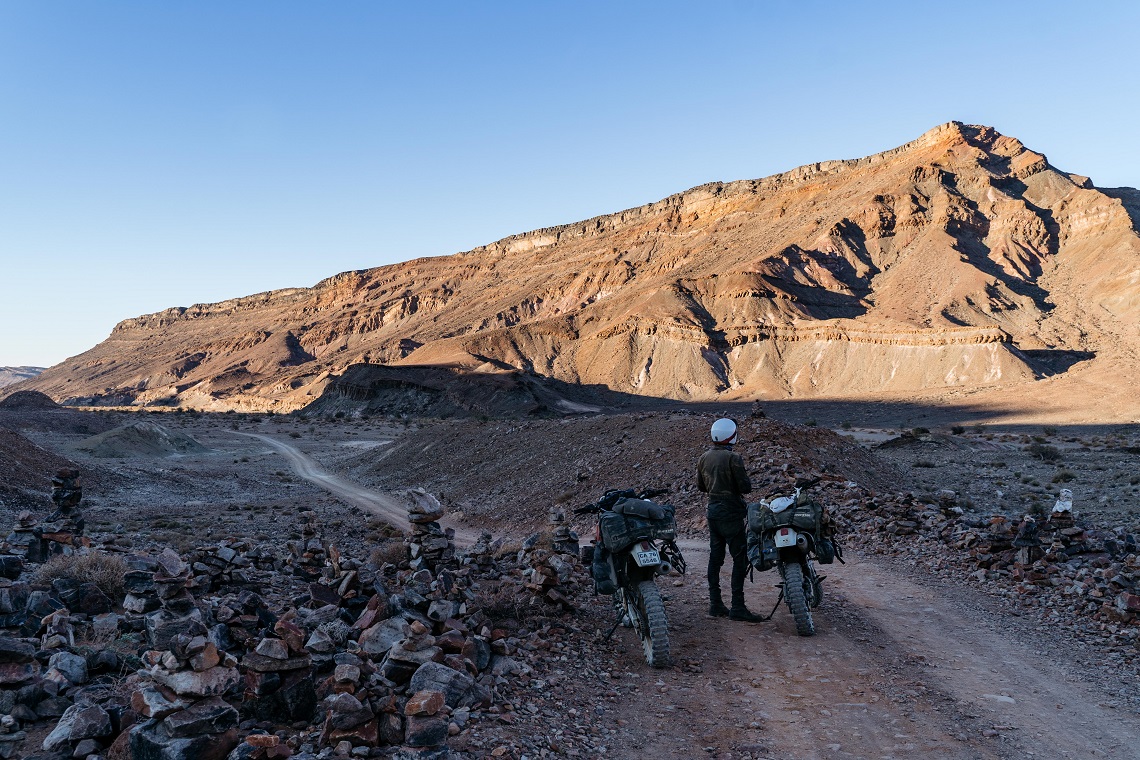
As we left a dry riverbed and rounded a corner, we noticed the first hill climb of the route where a small group of 4×4 enthusiasts who were travelling together had gathered. They clearly didn’t think they could make the climb and were turning around. One by one, inch by inch, they moved forwards and backwards until they could depart safely the same way we had all arrived. It was amusing to observe and gave us some respite before we rode onwards.
We hacked our way up that climb and the near-vertical hills that followed, our laden bikes and tired bodies moving slowly forwards. The dusty dry heat enveloped me as I slowly made progress. I’d dropped my bike twice already and drained a lot of much-needed energy getting it upright again. Then I realised I’d snapped my steel pannier rack on the second fall, damn it.
Bernard and Archie have an enduro riding background and were far more skilled at covering the sandy terrain than me, but sadly our bikes weren’t up to the task. The realisation was slowly dawning that we were moving far slower than was necessary to complete the trail in a safe window of time.
Decision time
Many hours and a few rest stops later, we decided to set up camp for the night having only covered a measly few miles to reach that point. While we wolfed down our hard-earned dinner, we all debated the next few days of riding and poured over our maps to get an understanding of the route ahead.
There was no getting away from the fact we were moving too slowly. Our water supplies were only suitable for 24 hours without refilling and getting stuck out in this arid landscape without water wasn’t worth the risk.
So, the following morning we packed up and headed back down the way we came via Kuboes, stopping in the little village to rest in the shade and enjoy an ice-cold Coke before making a new plan for the days ahead.
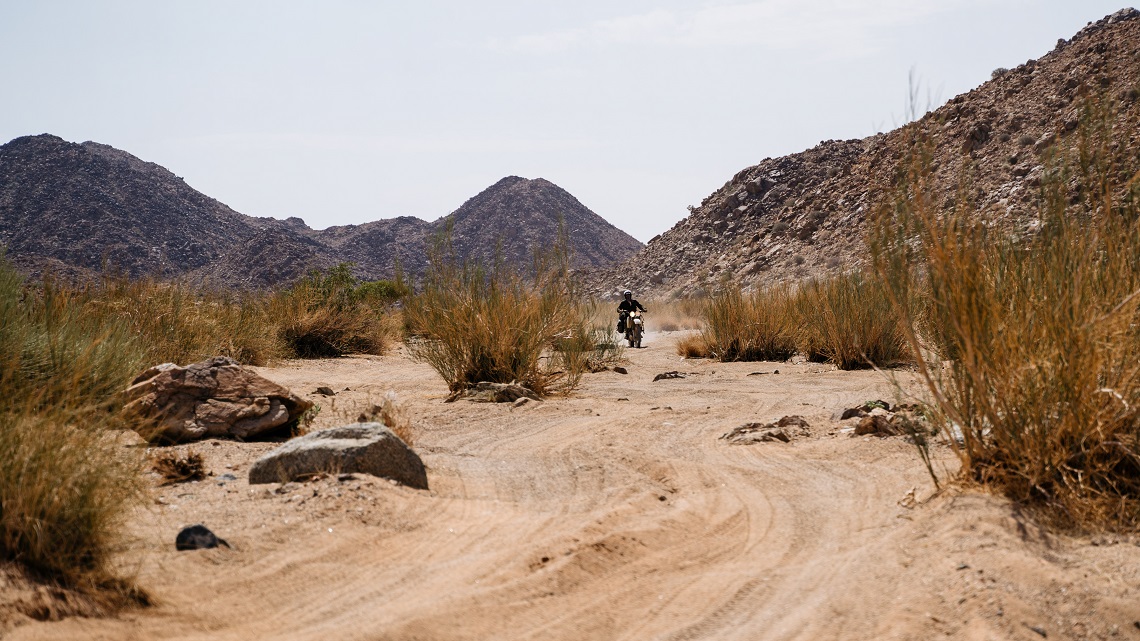
This was also the hottest day of the trip with the temperature rising to a scorching 40C. After a hard morning getting off the technical track, we still had a lot of ground to cover before reaching our camping destination for the day, the Orange River.
Just as our hunger levels started to enter the grumpy zone, Archie spotted a puncture on his front tyre. Fixing a flat on the road in the baking sun is tough enough already, but this was the worst possible timing because we were all absolutely knackered from the arduous trail.
But we were in this together and we wasted no time, all of us chipping in to get the puncture repaired as quickly as possible.
Our eventual campsite along the banks of the Orange River was the perfect place to wash away our worries from the last 24 hours. The oasis in the desert was well-received by all of us and we even managed to score a few beers from the camp manager. We pitched our tents, shared a few stories around the fire, and laughed at our antics from the day. A wash and a couple of beers made all well again in our little world.
Running out of fuel
That morning by the river started slowly. After a few hours spent repairing my broken pannier rack and some minor bits on the other bikes, we finally hit the road. Fuel was our challenge for the day as we slowly realise that the supply was limited in the area. Worryingly, we had quite a chunk of mileage to cover before we were safely in range of a petrol station.
Our only option was to barter what we could with the rafting camps along the river. Luckily the bikes didn’t require nearly as much fuel as any of the overloaded cars passing by but we had to make a few stops before we had bought enough for everyone to be in the clear.
We had one more day riding east alongside the mighty Orange River, before we had to leave the sanctuary it had become for us. Later on in the day, the perfect wild camping spot presented itself and we settled in for the night, our only neighbours being from the local Land Rover club, parked up further downstream.
The following morning, we left the river behind as we rode inland away from the captivating desert Richtersveld terrain that we had been exploring over the past few days.
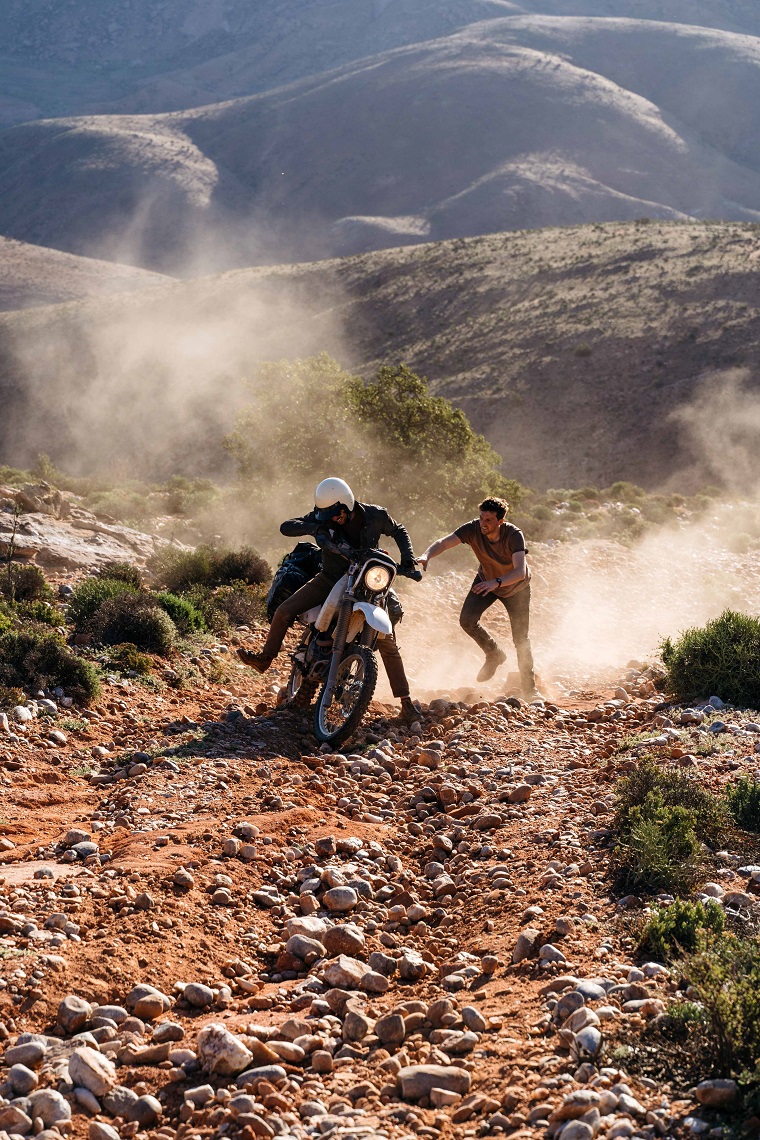
We joined a road which was long and straight, pointing our bikes southwards as we did our best to outrun a scary-looking weather system that seemed to be moving towards us.
The temperature dropped suddenly, and we all stopped briefly to put another few layers on. After a few hours of riding, we’d managed to keep ahead of the storm, and as we arrived in the town of Loeriesfontein, we decided to hide from the weather in the old town hotel which was basic but comfortable.
Riding in the Richtersveld and west coast of South Africa is truly beautiful. The diverse landscape is always changing and offers a wide variety of riding, along with picturesque environments. We visited in spring which worked out well as it was before the heavy summer heat arrived, but autumn would also be good before winter arrives on the coast.
–
We ride on the left-hand side of the road down here in South Africa and if you’re on a budget, a daily spend of £40 would easily suffice. Finding petrol was a challenge and I’d recommend checking for fuel stops along your route before heading out or making allowances to carry some extra fuel through certain sections.
We had a home-cooked meal at the local pub and a cold beer to warm our hearts after a long day’s slog on the bikes. It was everything we needed. Tomorrow would be last day of our trip.
We’d covered 1,300 miles, revelled in exploring remote wilderness, and suffered a long list of mechanical problems along the way. But the spilt oil and flat tyres were outnumbered by the laughs a bunch of mates had enjoyed along the way.
Tomorrow would be a long day as we hauled ourselves some 300 miles way back to Cape Town, but for now, we would enjoy a last night away from the hustle and bustle of the city we had so quickly forgotten together.
The Bike
My bike is a 1998 Honda XR600R, a desert racer built by Honda to tackle the Baja endurance races. It is as simple as they come, with a kick start, no electrics, and it’s air-cooled. In my opinion, it’s the perfect machine for escaping the crowds. It’s simple to fix and has never let me down. Even if tape is holding it together, it will always get me home.
I have fitted a long-range tank which allows me to cover about 220 miles. I’ve upgraded the suspension front and back for a stiffer rating, and I’ve also added luggage racks to carry my gear The front headlight isn’t original, I added the round light for a more vintage look. The thumper engine is powerful enough to cover decent mileage when travelling, but it isn’t overly heavy for technical riding.

